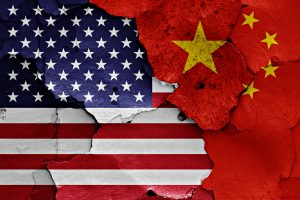Beijing increasingly faces hard choices and high stakes as Vladimir Putin’s war in Ukraine is mired in miscalculations. Xi Jinping raised the stakes of China’s strategic cooperation with Russia with the characterization of relations with “no limits” at their February 4 meeting. China’s partnership with Russia, short of a formal alliance, serves Beijing’s long-term strategic priorities. China’s refusal to condemn Russia’s invasion of Ukraine, confirmation of bilateral relations as “rock-solid,” and criticism of the West’s sanctions on Russia exert Beijing’s dominant leadership position in China-Russia relations. Moreover, China’s superior stature in bilateral relations reinforces the Chinese Communist Party’s political authority and legitimacy in domestic politics.
From the CCP’s perspective, Beijing’s identification with Moscow amplifies the credibility of authoritarian rule under Xi’s leadership on the global stage. China’s calculus pivots on legitimizing Russia’s invasion of Ukraine as a justified response to the United States, which Chinese officials call “the initiator of the crisis and contracting party.” In placing the onus on the United States for Russia’s invasion of Ukraine, Beijing has upped the ante in China-U.S. geostrategic rivalry.
A protracted conflict in Ukraine will likely continue to accelerate Russia’s reliance on China. Russia’s request for military and economic assistance from China, according to media reports based on U.S. intelligence assessments, is an indicator of this trajectory.
On March 20, two days after the video meeting between Presidents Biden and Xi, China’s ambassador to the U.S., Qin Gang, stated, “China’s trust relations with Russia, it’s not a liability, actually it’s an asset in the international efforts to solve the crisis in a peaceful way. China is part of the solution, it’s not part of the problem.” The ambassador’s emphasis on China’s “trusted” relations with Moscow and role as “part of the solution” is Beijing’s attempt to elevate China to the status of “peaceful” arbiter and problem solver – a direct rebuke of U.S. leadership in the Ukraine crisis.
Concurrently, in re-affirming the trust between China and Russia, Beijing benefits from Russia as a source of energy security and Moscow’s military-technology expertise, advanced nuclear weapons capabilities, and U.N. Security Council voting power. Russia’s reciprocity could fortify China’s long-term strategic positioning vis-à-vis China-U.S. great power competition on four fronts: Taiwan and the Indo-Pacific, Europe, Iran, and the Middle East, and the Arctic.
With China’s support, Russia’s assault on Ukraine is testing the EU-U.S. long-term commitment in countering authoritarian aggression, contradictions, and disinformation. It would be useful to understand that Beijing’s rhetorical contradictions, which have been well-documented, reflect a long-standing pattern of communist polemics, which the CCP utilized to its advantage to precipitate the Sino-Soviet split in the Cold War. The weaponization of information in the current Ukraine conflict has deep-seated origins in Soviet bloc dialectics.
Contradictions, or objective, incompatible differences, functioned as a crucial component in the construction of Sino-Soviet East Europe relations from 1953-1960. The PRC’s policy toward Soviet Eastern Europe evolved from and revolved around constant contending with contradictions in domestic as well as intra-bloc politics. Utilizing Marxist-Leninist ideology Mao Zedong exploited natural contradictions inherent in China’s relations with the Soviet bloc. Communism created a culture of calculated chaos and a political construct of confusion. The aim of the game was not so much to win but to beguile friends and foes into a realm of constant doubt, distrust, and deception, the very fibers of the communist fabric. Communist leaders, including Nikita Khrushchev, Mao Zedong, Wladyslaw Gomulka, Josef Tito, and the others in the Soviet satellite states followed an agenda of ambiguity in which policies were formulated not only for the purpose of implementation but also to obfuscate opponents and disenfranchise detractors.
Following the old playbook, Chinese media censors continue to propagate pro-Russia sentiments, spread disinformation on purported U.S. bioweapon research labs in Ukraine, and stifle Chinese public criticism of Russia’s military action. Despite Washington’s call for Beijing to encourage Russia to “do the right thing,” China will define what is “right” and make choices to advance the CCP’s geopolitical, military, technological, and economic agenda. The Chinese state makes choices that shape a risk environment conducive to national interests above all else.
In contrast to Russia, the China market remains a magnet for global trade and center of gravity for investment, manufacturing, and supply chains – advantages that China can leverage. The Chinese government is pursuing measures to avoid secondary sanctions to hedge against the West’s reprisals. Though China might face short-lived reputational risk for supporting Russia, Beijing likely perceives that the West’s opprobrium will be fleeting and fickle in the near term. Looking longer term, China is more intent on using the Ukraine conflict to erode U.S. leadership and sow division in transatlantic relations. Although the United States and EU have converged with surprising speed on shared sanctions against Russia, China will continue to exacerbate fissures in U.S.-EU-NATO strategic interests and further aggravate cleavages in intra-EU politics.
Moscow, with help from Beijing, is attempting to rewrite reality in Ukraine, Europe, and more broadly, the global order. For Putin, reviving Russia’s dominance across Europe is paramount. For Xi, restoring China’s centrality in the global order is inarguable. For Russia and China, exporting an authoritarian alternative to a U.S.-EU led liberal world order is a shared imperative. For the United States, shoring up sustained support and cohesion from like-minded nations in Europe and Indo-Pacific will be pivotal for international security. For the global community, the fault lines between democracy and autocracy are framing the future according to two starkly divergent worldviews.

































